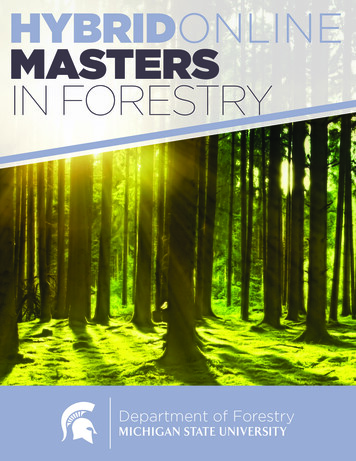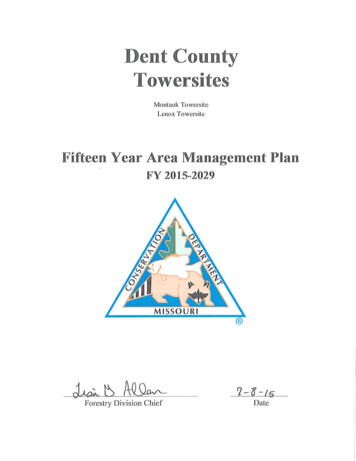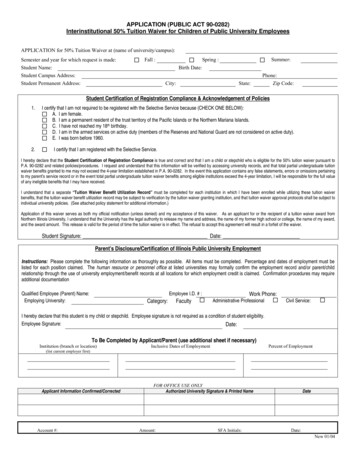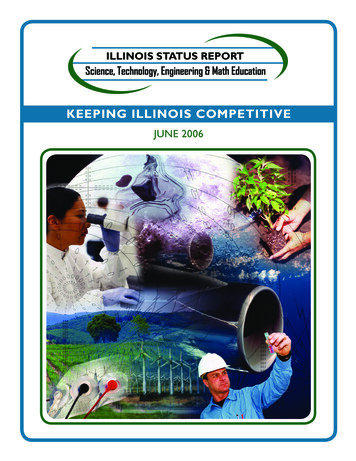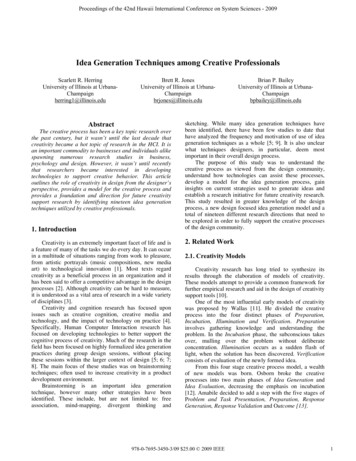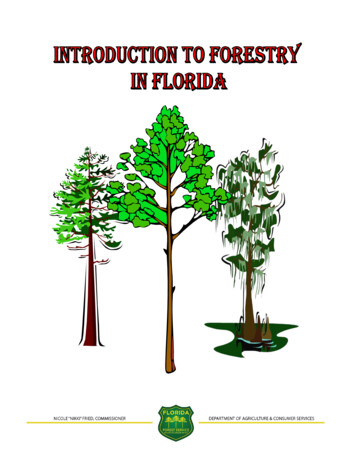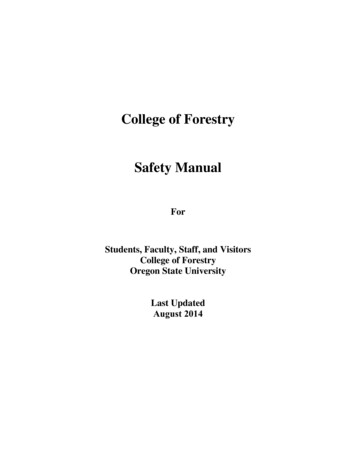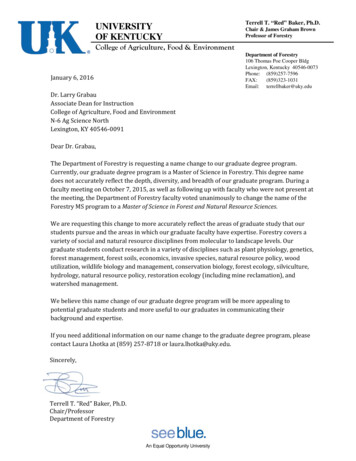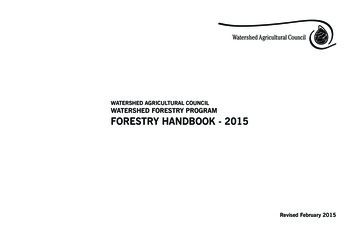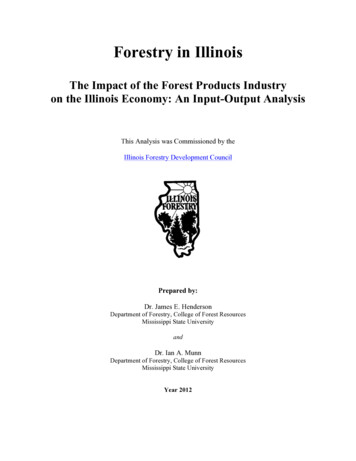
Transcription
Forestry in IllinoisThe Impact of the Forest Products Industryon the Illinois Economy: An Input-Output AnalysisThis Analysis was Commissioned by theIllinois Forestry Development CouncilPrepared by:Dr. James E. HendersonDepartment of Forestry, College of Forest ResourcesMississippi State UniversityandDr. Ian A. MunnDepartment of Forestry, College of Forest ResourcesMississippi State UniversityYear 2012
Citation:Henderson, J.E. and I.A. Munn. 2012. Forestry in Illinois – The Impact of the Forest ProductsIndustry on the Illinois Economy: An Input-Output Analysis. Illinois Forestry DevelopmentCouncil. 22 p.1
INTRODUCTIONForest resources are a major component of Illinois’ resource base. Timberland accounts for13.4% of the state’s total land area, covering over 4.78 million acres (USDA-Forest Service).Capitalizing on this resource base, the forest products industry makes an important contributionto Illinois’ economy.The forest products industry includes four main sectors, logging, solid wood products, pulp andpaper, and wood furniture manufacturing, and two related sectors, miscellaneous forest productsand urban forestry. The impact of the forest products industry on Illinois’ economy is measuredby four key statistics: employment - the number of full- and part-time jobs in the sector;employee compensation - the wages paid by the sector; output - the sector’s total value ofproduction; and value-added - total sector output minus the costs of purchased inputs. Valueadded represents the amount of money available for disbursement, either in the form of wages,owner compensation, or taxes.Forest products industry sectors impact Illinois’ economy in three ways. First, these sectorsimpact the state economy directly through their own employment, wages, production, and valueadded. Second, there is an indirect effect resulting from the industry’s purchase of goods andservices from supporting industries located in the state, resulting in increased employment,wages, production, and value-added in these supporting industries to meet the demands of theforest products industry. Finally, there is an induced effect, resulting from purchases ofconsumer goods and services by employee households associated with both the forest productsindustry and its supporting industries.This study evaluates the importance of the forest products industry to the state’s economy.METHODSInput-Output Modeling - Forest industry economic impacts were modeled using the ImpactAnalysis for Planning (IMPLAN) System, originally developed by the USDA Forest Service incooperation with the Federal Emergency Management Agency and the University of Minnesota.The IMPLAN model was designed by the Forest Service to estimate the regional economic impactsof management plans for National Forests (Alward et al. 1985; MIG, 2004). IMPLAN is acomputerized database and modeling system for constructing regional economic accounts andregional input-output tables. The IMPLAN model used a 440 sector input-output transactions tablebased upon the Bureau of Economic Analysis' National I-O table (USDC 1984). The MinnesotaIMPLAN Group, Inc. of Stillwater, Minnesota, a commercial venture, provides current data andanalytical support necessary to run the model (MIG, 2004).For reporting purposes, this study combines the results for the 440 sectors into 32 aggregated sectors– 4 major forest products sectors, 2 sectors of miscellaneous forestry related activities, and 26 nonforestry related sectors (Table 1). This procedure follows Barnett and Reinschmiedt (1996) whomodeled the Mississippi agriculture industry using 45 aggregated sectors – 26 food and fiber sectorsand 18 non-food and non-fiber sectors. The focus of this study is the forest products industry;2
therefore, the non-forestry related sectors were further aggregated into three sectors: agriculturalproduction, agricultural processing, and food processing, following Munn (1998). Similaraggregation schemes were used in Xu (2002), Munn and Henderson (2003), Hodges et al. (2005),Mehmood and Pelki (2005), and Henderson et al. (2008). IMPLAN data for 2010, the mostrecent available, were used.The impact of the four primary sectors and two related sectors of the forest products industry wereexamined individually, followed by the impact of the entire industry. Direct impacts of the sixsectors and the entire forest products industry were obtained from IMPLAN’s study area data forIllinois. Total impacts (i.e. direct, indirect, and induced) were estimated within the IMPLAN modelby removing the total employment for the relevant sector and calculating the impact on the stateeconomy resulting from the total loss of industry production for that sector. This is the procedurerecommended by the Minnesota IMPLAN Group Inc. (2000) for estimating the economic impact ofan industry. This will also provide information about which industries benefit the most from theforest products industry. The importance of Illinois’ forest products industry to the state, local, andfederal governments were also examined through tax revenue generated.RESULTSTable 2 provides data on the direct impacts on Illinois’ economy of the industry aggregations usedin this study. Employment, wages and salaries, output, and value-added are reported for eachindustry aggregation. The forest products industry (all forest-related sectors) employed 36,309people in 2010, roughly 0.5% of the state’s total employment of 7,264,332. The industry paid outover 2.8 billion in wages. The industry’s average annual wage was 77,715. The average industrywage was calculated by dividing the wages and salaries for all forestry related sectors by theemployment for all forestry related sectors given in Table 2. Value-added generated by the industrytotaled over 3.0 billion.Each sector of the forest products industry made substantial contributions to the state economy.Tables 3 to 8 provide data on the total impacts (i.e. direct, indirect and induced) of themiscellaneous forest products, urban forestry, logging, solid wood products, pulp and paper, andwood furniture sectors on the state economy, respectively. Total impacts are reported by aggregatedindustrial sectors. In general, the impacts reported for each forestry sector are direct impacts, whilethe impacts reported for all other sectors are indirect and induced impacts. The total impact of thespecific forestry sector evaluated on the state economy is summarized in the table row titled Totals.Table 9 provides data on the total impacts of the aggregated forest-related sectors. Summing theimpacts of the individual forest-related sectors overestimates the impacts of the forest productsindustry. Considered separately, each sector has indirect and induced impacts on the other forestrelated sectors. However, when all forest-related sectors are considered as a group, these impactsare internal and thus do not result in additional indirect or induced impacts. Controlling for indirectand induced impacts between forest-related sectors allows IMPLAN to internalize these impacts andgenerate the true impact of the forest products industry on the state economy.3
Miscellaneous Forests ProductsThe miscellaneous forests products sector includes all establishments engaged in activitiesaffiliated with forestry, such as tree nurseries, forestry consultants, and support activities forforestry. Support activities for forestry are included in IMPLAN sector 15, support activities foragriculture and forestry, which includes three four digit NAICS sectors: support activities forcrop production, 1151; support activities for animal production, 1152; and support activities forforestry, 1153. The U.S. Census Bureau 2009 County Business Patters data base indicates theannual payroll for the three NAICS sectors. This information was used to estimate the proportionof IMPLAN sector 15 that each of the three sub sectors comprise. The support activities forforestry proportion of the output, employment, wages and salaries, and value-added for IMPLANsector 15 was subtracted from the IMPLAN study area data values and listed separately with theaggregated miscellaneous forest products sector. The remaining portion of IMPLAN sector 15,accounting for support activities for crop production and support activities for animal production,was included in the aggregated resource services sector. Thus, only the portion of IMPLANsector 15 relating to forestry activities was included in the direct effects for this study.Miscellaneous forest products establishments represent the smallest forestry-related sector buttheir services are critical to the other sectors in the industry. Firms in the miscellaneous forestproducts sector employed 468 people and paid 12.3 million in wages. Value-added exceeded 22 million (Table 2). The total effect (i.e. direct, indirect, and induced) of this sector onIllinois’ economy was even greater (Table 3). In 2010, 965 jobs were related to activitiesassociated with the production of miscellaneous forest products with wages totaling 38.49million. Miscellaneous forest products generated an estimated 110.9 million addition toIllinois’ total industry output and 63.6 million in value-added to Illinois’ economy. Based onemployment, miscellaneous services, wholesale and retail trade, education, financial and realestate, government, and health services are among those sectors that benefit substantially fromthe indirect and induced impacts created by this sector.Urban forestryThe urban forestry sector includes all firms engaged in urban forest management, tree pruning,removal, trimming, arboriculture, and related services. There is no IMPLAN sector thatcorresponds directly to urban forestry. Urban forestry activities are included as a part of a muchlarger sector - IMPLAN sector 388, services to buildings and dwellings. The output value for urbanforestry related activities was estimated using results from Sass et al. (2010) indicating a totalexpenditure of 178,432, 101 in 2009. Using the output value of 178.4 million, the correspondingemployment, wages and salaries, and value-added were obtained from the IMPLAN study area datavalues for sector 388. As urban forestry, within the original IMPLAN data set, is included in thismuch larger sector, the component represented by urban forestry related activities was subtractedfrom sector 388 IMPLAN study area data values and included as a separate sector in the directeffects for this study along with other forestry related sectors.In 2010, urban forestry firms employed 2,696 workers and paid 74.79 million in wages. Theaverage annual wage was 27,741. Total industry output for the sector was 98.75 million andthe value-added totaled 22.07 billion (Table 2). Other industrial sectors that benefited from the4
indirect and induced impacts of the urban forestry sector included miscellaneous services,wholesale and retail trade, financial and real estate, education, health services and government.Direct, indirect, and induced employment totaled 5,214. Total wages totaled 208.96 million.Industry output related to the activities of the urban forestry sector amounted to 521.53 millionwith an associated 316.87 million in value-added (Table 4)LoggingThe logging sector includes all establishments engaged in cutting timber and producing rough,round, hewn, or riven primary forestry and wood raw materials, including wood chips, in thefield. Logging is extremely important to Illinois’ economy for two reasons. First, the sector isessential in providing wood-based raw materials for the rest of the forest products industry.Second, the sector is important because of the economic contributions it makes through its ownemployment and income creation.Timber is an important crop. The direct effect of the industry was substantial. Landownersreceived 16.66 million for their standing timber (Topinka 2011). Logging firms employed 662people and paid 16.18 million in wages. Total industry output, the value of Illinois’ timberharvest at the point of first processing was 51.49 million. Value-added exceeded 16.98million (Table 2). The total effect of logging on Illinois’ economy was even greater (Table 5).In 2010, 1,190 jobs were related to timber harvesting activities with wages totaling 45.35million. Logging generated an estimated 122.1 million addition to Illinois’ total industry outputand 61.68 million in value-added to Illinois’ economy. Miscellaneous services, wholesale andretail trade, financial and retail trade, education, health services, and government are amongthose sectors that benefit substantially from the indirect and induced impacts created by thelogging industry based on employment. However, the sector’s overall importance was muchgreater than stated here. Timber harvesting and transportation are essential for solid woodproducts, pulp and paper, and wood furniture manufacturing - three sectors that make up theremainder of the forest products industry in the state.Solid Wood ProductsThe solid wood products sector is a major component of Illinois’ forest products industry and akey component of the state economy. Included in this sector are sawmills, plywood mills, veneermills, reconstituted wood product mills, and firms manufacturing articles made primarily ofwood (Table 1). In 2010, these firms directly employed 6,675 workers and paid 368 million inwages. The average annual wage was 54,365. Industry output for the sector was 1.02 billionand the value-added exceeded 376 million (Table 2).The total impact of the solid wood products sector on Illinois’ economy was substantial. Thissector generated 18,316 jobs, either directly or in supporting industries. Employee compensationfor these jobs was over 917 million, annually. Total value-added was exceeded 1.37 billionand industry output generated by the solid wood products sector and its supporting industriesamounted to 2.59 billion (Table 6).5
Pulp and PaperPulp mills, paper mills, paperboard mills, and manufacturers of paperboard containers and boxes,converted paper and paperboard products and other related paper products are included in thissector (Table 1). In 2010, these firms employed 18,645 workers and paid 1.92 billion in wages.The average annual wage was 103,111, almost 20,000 greater than the state average. Totalindustry output for the sector was 7.47 billion and value-added by manufacturing exceeded 1.99 billion (Table 2).The indirect and induced impacts of the pulp and paper sector had a major impact on themiscellaneous services, wholesale and retail trade, financial and real estate, education,government, health services, transportation and communications, and construction, increasingemployment in these sectors by more than 2,700 each. The number of full- and part-time jobsgenerated by the pulp and paper sector, either directly, indirectly or through induced impacts,totaled 90,425. Total wages exceeded 5.38 billion. Industry output related to pulp and papersector activities amounted to 17.60 billion with an associated 8.35 billion value-added (Table7).Wood FurnitureThis sector includes firms that manufacture wood household furniture, upholstered furniture onwood frames, wood office furniture, and wood partitions and fixtures (Table 1). In 2010, thesefirms employed 7, 072 workers and paid 428 million in wages. The average annual wage was 60,554. Total industry output for the sector was 1.03 billion and the value-added bymanufacturing totaled 433.4 million (Table 2).Other industrial sectors that benefited from the indirect and induced impacts of the woodfurniture sector included the miscellaneous services, wholesale and retail trade financial and realestate, education, health services, government sectors. Direct, indirect, and induced employmenttotaled 20,267. Total wages totaled 1.05 billion. Industry output related to the activities of thewood furniture and related products sector amounted to 2.83 billion with an associated 1.58billion in value-added (Table 8).Total Industry ImpactIn 2010, the combined impact of all sectors of the forest products industry on Illinois’ economywas dramatic. Forestry related employment (i.e. direct, indirect, and induced) accounted for1.8% of all jobs in Illinois. The average annual wage in forestry related occupations was 61,609(Table 2).In Illinois, total industry output related to the forest products industry exceeded 23.08 billionand related value-added was over 11.4 billion. Related employment totaled 131,549 full- orpart-time jobs with an associated annual payroll of 8.10 billion (Table 9). The industrial sectorsthat benefit most from the forest products industry are miscellaneous services, wholesale andretail trade, financial and real estate and education. Wholesale and retail trade output generated6
by the forest products industry, for example, was 1.7 billion, accounting for 16,268 additionaljobsIllinois’ forest products industry generated over 2.49 billion in tax revenue in 2010. Federalgovernment, non-defense, taxes exceeded 1.6 billion (Table 10a). State and local government,non-education, taxes totaled over 871 million (Table 10b).7
LITERATURE CITEDAlward, G.S., H.C. Davis, K.A. Depotakis, and E.M. Lofting. 1985. Regional non-survey inputoutput analysis with IMPLAN. Paper presented at the Southern Regional ScienceAssociation Conference. Washington, D.C. May 9-10, 1985.Barnett, B. and L. Reinschmiedt. 1996. Agriculture and Forestry in Mississippi - An Analysis of theImpacts of Food and Fiber Related Sectors on the Mississippi Economy. AgriculturalEconomics Technical Bulletin No. 95. Mississippi State University, Mississippi State,Mississippi.Henderson, J.E. 2008. 2007 Harvest of Forest Products. Forest Resources Market Notes,Cooperative Extension Service, Mississippi State University, Mississippi State, Mississippi.Hodges, A.W., W.D. Mulkey, J.R. Alavalapati, D.R. Carter, and C.F. Kiker. 2005. Economicimpacts of the forest industry in Florida, 2003. Institute of Food and Agricultural Sciences,University of Florida.Mehmood, S.R., and M.H. Pelkki. 2005. The Arkansas forest products industry, 1985-2001.Arkansas Forest Resources Center Series 006, School of Forest Resources, University ofArkansas-Monticello, Monticello, AR.Minnesota IMPLAN Group, Inc. 2000. Introduction to IMPLAN. Minnesota IMPLAN Group,Inc., Stillwater, Minnesota.Minnesota IMPLAN Group, Inc. 2004. IMPLAN ProfessionalTM: User’s Guide, Analysis Guide,Data Guide, Minnesota IMPLAN Group, Inc. Stillwater, MN.Munn, I.A. 1998. Forestry in Mississippi - The Impact of the Forest Products Industry on theMississippi Economy: An Input-Output Analysis. Forest and Wildlife Research Center,Research Bulletin FO 087. Mississippi State University, Mississippi State, Mississippi.Munn, I.A. and J.E. Henderson. 2003. Forestry in Mississippi: The Impact of the ForestProducts Industry on the Mississippi Economy – An Input-Output Analysis. ResearchBulletin FO 216, Forest and Wildlife Research Center, Mississippi State University.Sass, L., R. Hildebrandt, and S. Key. 2010. Illinois urban and community tree programs: anupdate of the protection, care, and management of our urban forests. Illinois NaturalHistory Survey Technical Report 2010 (52).Topinka, J.B. 2011. State of Illinois Comptroller. Available: http://www.wh1.ioc.state.il.usUnited States Census Bureau. County Business Patterns. Available:http://www.census.gov/econ/cbp/8
United States Department of Commerce 1984. The detailed input-output structure of the U. S.economy, 1977. The Use and Make of Commodities by Business. Vol. 1. U.S. Departmentof Commerce, Bureau of Economic Analysis, Washington, D.C.USDA Forest Service, Forest Inventory and Analysis Program. Available:http://www.fia.fs.fed.us/tools-data/Xu, W., 2002. Economic impact of the Texas forest sector. Publication 161, Texas Forest Service,College Station, TX.9
Table 1. Aggregation Scheme of Commercial Sectors used for IMPLAN Input-Output Analysis of the ForestProducts Industry Impacts on the Illinois Economy, 2010.MODEL SECTORSMISCELLANEOUS FORESTPRODUCTSURBAN FORESTRYLOGGINGSOLID WOOD PRODUCTSWOOD FURNITUREPULP AND PAPERRESOURCE RICULTURALPROCESSINGFOOD PROCESSINGFARM INPUTS ANDMACHINERYFABRIC MILLS ANDLEATHERPETROLEUM ANDCHEMICALSORIGINAL IMPLAN SECTORSForest nurseries, forest products, and timber tracts; Agriculture and forestry support activitiesServices to buildings and dwellingsLoggingSawmills; Wood preservation; Reconstituted wood product manufacturing; Veneer and plywoodmanufacturing; Engineered wood member and truss manufacturing; Cut stock, resawing lumber,and planning; Other millwork, including flooring; Wood container and pallet manufacturing;Prefabricated wood building manufacturing; Miscellaneous wood product manufacturing; Woodwindows and door manufacturingWood kitchen cabinet and countertop manufacturing; Upholstered household furnituremanufacturing; Nonupholstered wood household furniture manufacturing; Wood office furnituremanufacturing; Custom architectural woodwork and millworkPulp mills; Paper and paperboard mills; Paperboard container manufacturing; Surface-coatedpaperboard manufacturing; Coated and laminated paper and packaging materials; Coated anduncoated paper bag manufacturing; Die-cut paper office supplies manufacturing; Envelopemanufacturing; Sanitary paper product manufacturing; All other converted paper productmanufacturingFishing; Hunting and trapping; Agriculture and forestry support activitiesOil and gas extraction; Coal mining; Iron ore mining; Copper, nickel, lead, and zinc mining; Gold,silver, and other metal ore mining; Stone mining and quarrying; Sand, gravel, clay, and refractorymining; Other nonmetallic mineral mining; Drilling oil and gas wells; Support activities for oil andgas operations; Support activities for other miningNew residential 1-unit structures, nonfarm; New multifamily housing structures, nonfarm; Newresidential additions and alterations, nonfarm; New farm housing units and additions and alterations;Manufacturing and industrial buildings; Commercial and institutional buildings; Highway, street,bridge, and tunnel construction; Water, sewer, and pipeline construction; Other new construction;Maintenance and repair of farm and nonfarm residential structures; Maintenance and repair ofnonresidential buildings; Maintenance and repair of highways, streets, bridges, and tunnels; Othermaintenance and repair constructionOilseed farming; Grain farming; Vegetable and melon farming; Tree nut farming; Fruit farming;Greenhouse and nursery production; Tobacco farming; Cotton farming; Sugarcane and sugar beetfarming; All other crop farming; Cattle ranching and farming; Poultry and egg production; Animalproduction, except cattle and poultry and eggsDog and cat food manufacturing; Other animal food manufacturing; Flour milling; Rice milling;Wet corn milling; Soybean processing; Other oilseed processing; Fats and oils refining andblending; Breakfast cereal manufacturing; Fluid milk manufacturing; Creamery buttermanufacturing; Cheese manufacturing; Dry, condensed, and evaporated dairy products; Ice creamand frozen dessert manufacturing; Animal, except poultry, slaughtering; Meat processed fromcarcasses; Rendering and meat byproduct processing; Poultry processingMalt manufacturing; Sugar manufacturing; Confectionery manufacturing from cacao beans;Confectionery manufacturing from purchased chocolate; Nonchocolate confectionerymanufacturing; Frozen food manufacturing; Fruit and vegetable canning and drying; Seafoodproduct preparation and packaging; Frozen cakes and other pastries manufacturing; Bread andbakery product, except frozen, manufacturing; Cookie and cracker manufacturing; Mixes and doughmade from purchased flour; Dry pasta manufacturing; Tortilla manufacturing; Roasted nuts andpeanut butter manufacturing; Other snack food manufacturing; Coffee and tea manufacturing;Flavoring syrup and concentrate manufacturing; Mayonnaise, dressing, and sauce manufacturing;Spice and extract manufacturing; All other food manufacturing; Soft drink and ice manufacturing;Breweries; Wineries; Distilleries; Tobacco stemming and redrying; Cigarette manufacturing; Othertobacco product manufacturingNitrogenous fertilizer manufacturing; Phosphatic fertilizer manufacturing; Fertilizer, mixing only,manufacturing; Pesticide and other agricultural chemical manufacturing; Farm machinery andequipment manufacturing; Lawn and garden equipment manufacturingFiber, yarn, and thread mills; Broadwoven fabric mills; Narrow fabric mills and schiffli embroidery;Textile and fabric finishing mills; Leather and hide tanning and finishing; Other leather productmanufacturingPetroleum refineries; Asphalt paving mixture and block manufacturing; Asphalt shingle and coatingmaterials manufacturing; Petroleum lubricating oil and grease manufacturing; All other petroleumand coal products manufacturing; Petrochemical manufacturing; Industrial gas manufacturing;Synthetic dye and pigment manufacturing; Other basic inorganic chemical manufacturing; Otherbasic organic chemical manufacturing; Plastics material and resin manufacturing; Synthetic rubber10
GLASS, STONE, AND CLAYMETAL INDUSTRIESMACHINERY ANDEQUIPMENTmanufacturing; Cellulosic organic fiber manufacturing; Noncellulosic organic fiber manufacturing;Pharmaceutical and medicine manufacturing; Paint and coating manufacturing; Adhesivemanufacturing; Soap and other detergent manufacturing; Polish and other sanitation goodmanufacturing; Surface active agent manufacturing; Toilet preparation manufacturing; Printing inkmanufacturing; Explosives manufacturing; Custom compounding of purchased resins; Photographicfilm and chemical manufacturing; Other miscellaneous chemical product manufacturing; Plasticspackaging materials, film and sheet; Plastics pipe, fittings, and profile shapes; Laminated plasticsplate, sheet, and shapes; Plastics bottle manufacturing; Resilient floor covering manufacturing;Plastics plumbing fixtures and all other plastics products; Foam product manufacturing; Tiremanufacturing; Rubber and plastics hose and belting manufacturing; Other rubber productmanufacturingVitreous china plumbing fixture manufacturing; Vitreous china and earthenware articlesmanufacturing; Porcelain electrical supply manufacturing; Brick and structural clay tilemanufacturing; Ceramic wall and floor tile manufacturing; Nonclay refractory manufacturing; Clayrefractory and other structural clay products; Glass container manufacturing; Glass and glassproducts, except glass containers; Cement manufacturing; Ready-mix concrete manufacturing;Concrete block and brick manufacturing; Concrete pipe manufacturing; Other concrete productmanufacturing; Lime manufacturing; Gypsum product manufacturing; Abrasive productmanufacturing; Cut stone and stone product manufacturing; Ground or treated minerals and earthsmanufacturing; Mineral wool manufacturing; Miscellaneous nonmetallic mineral productsIron and steel mills; Ferroalloy and related product manufacturing; Iron, steel pipe and tube frompurchased steel; Rolled steel shape manufacturing; Steel wire drawing; Alumina refining; Primaryaluminum production; Secondary smelting and alloying of aluminum; Aluminum sheet, plate, andfoil manufacturing; Aluminum extruded product manufacturing; Other aluminum rolling anddrawing; Primary smelting and refining of copper; Primary nonferrous metal, except copper andaluminum; Copper rolling, drawing, and extruding; Copper wire, except mechanical, drawing;Secondary processing of copper; Nonferrous metal, except copper and aluminum, shaping;Secondary processing of other nonferrous; Ferrous metal foundaries; Aluminum foundries;Nonferrous foundries, except aluminum; Iron and steel forging; Nonferrous forging; Custom rollforming; All other forging and stamping; Cutlery and flatware, except precious, manufacturing;Hand and edge tool manufacturing; Saw blade and handsaw manufacturing; Kitchen utensil, pot,and pan manufacturing; Prefabricated metal buildings and components; Fabricated structural metalmanufacturing; Plate work manufacturing; Metal window and door manufacturing; Sheet metalwork manufacturing; Ornamental and architectural metal work manufacturing; Power boiler andheat exchanger manufacturing; Metal tank, heavy gauge, manufacturing; Metal can, box, and othercontainer manufacturing; Hardware manufacturing; Spring and wire product manufacturing;Machine shops; Turned product and screw, nut, and bolt manufacturing; Metal heat treating; Metalcoating and nonprecious engraving; Electroplating, anodizing, and coloring metal; Metal valvemanufacturing; Ball and roller bearing manufacturing; Small arms manufacturing; Other ordnanceand accessories manufacturing; Fabricated pipe and pipe fitting manufacturing; Industrial patternmanufacturing; Enameled iron and metal sanitary ware manufacturing; Miscellaneous fabricatedmetal product manufacturing; Ammunition manufacturingConstruction machinery manufacturing; Mining machinery and equipment manufacturing; Oil andgas field machinery and equipment; Sawmill and woodworking machinery; Plastics and rubberindustry machinery; Paper industry machinery manufacturing; Textile machinery manufacturing;Printing machinery and equipment manufacturing; Food product machinery manufacturing;Semiconductor machinery manufacturing; All other industrial machinery manufacturing; Officemachinery manufacturing; Optical instrument and lens manufacturing; Other commercial andservice industry machinery manufacturing; Automatic vending, commercial laundry anddrycleaning machinery; Air purification equipment manufacturing; Industrial and commercial fanand blower manufacturing; Heating equipment, except warm air furnaces; AC, refrigeration, andforced air heating; Industrial mold manufacturing; Metal cutting machine tool manufacturing; Metalforming machine tool manufacturing; S
Department of Forestry, College of Forest Resources Mississippi State University and Dr. Ian A. Munn Department of Forestry, College of Forest Resources . forestry, 1153. The U.S. Census Bureau 2009 County Business Patters data base indicates the annual payroll for the three NAICS sectors. This information was used to estimate the proportion
